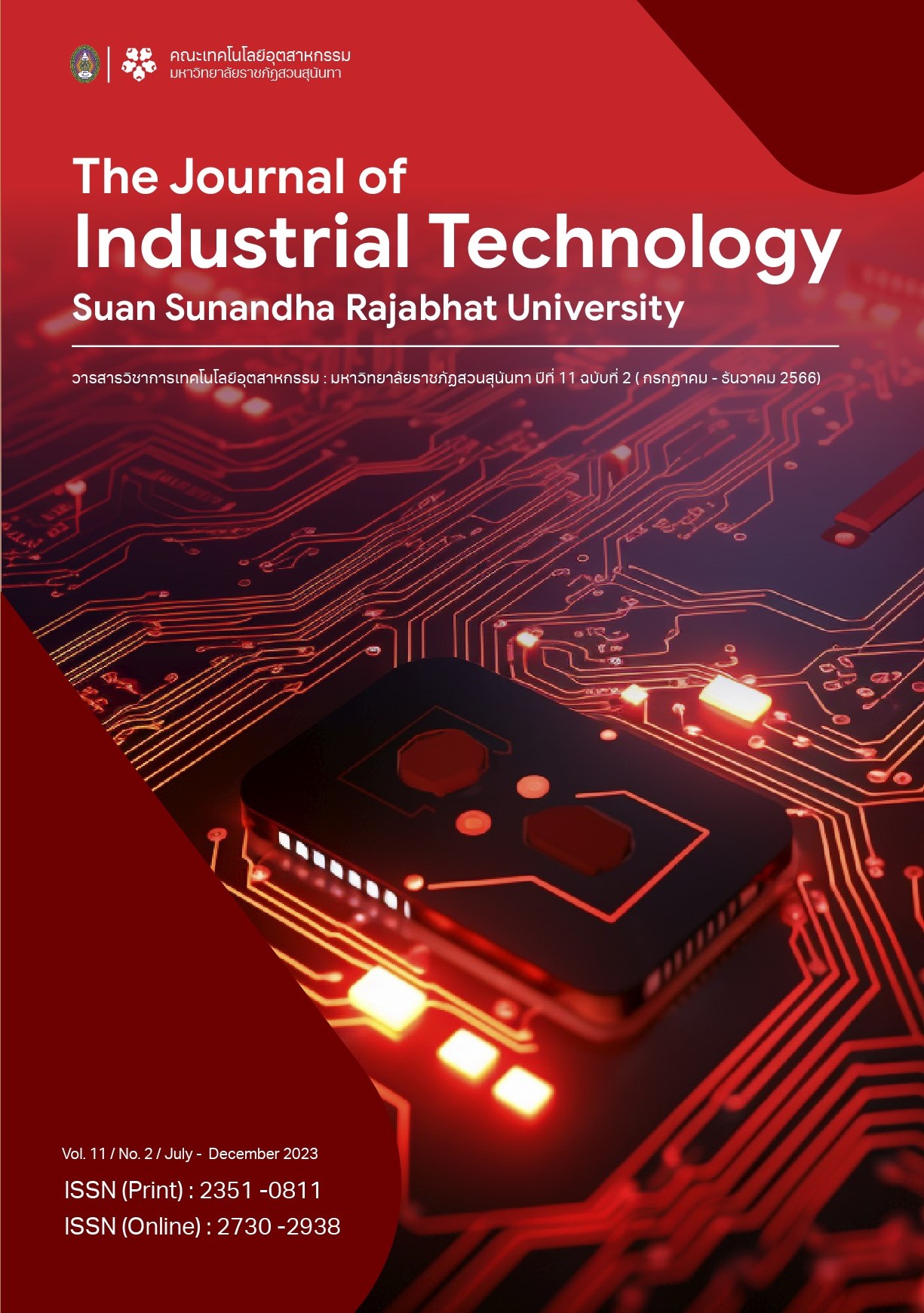การวิเคราะห์คุณสมบัติทางไฟฟ้าของมังคุดและตรวจจับเนื้อแก้วด้วยระบบเซนเซอร์ย่านความถี่เอ็กซ์
คำสำคัญ:
คุณสมบัติไดอิเล็กตริก, มังคุดเนื้อแก้ว, คลื่นสะท้อน, ระบบเซนเซอร์ไมโครเวฟบทคัดย่อ
บทความนี้นำเสนอการตรวจวัดคุณสมบัติทางไฟฟ้าของมังคุดเนื้อแก้วและมังคุดเนื้อปกติในช่วงความถี่ 10 ถึง 11 กิกะเฮิรตซ์ ข้อมูลที่ได้ถูกนำมาใช้ในการจำลองมังคุดในระบบตรวจวัดแบบเทคนิคอวกาศว่าง ระบบตรวจวัดประกอบด้วยสายอากาศรับส่งกำลังงานความถี่ แหล่งกำเนิดสัญญาณความถี่สูงแบบเรโซเนเตอร์ไดอิเล็กตริก วงจรผสมสัญญาณ มอเตอร์สำหรับหมุนผลมังคุดในขณะตรวจวัด อุปกรณ์ตรวจจับกำลังงาน วงจรแปลงสัญญาณแอนะล็อกเป็นสัญญาณดิจิทัล และบอร์ดไมโครคอนโทรลเลอร์ หลักการของระบบเซนเซอร์ คือ กำลังงานความถี่ถูกส่งออกไปยังผลมังคุดและรับกำลังงานคลื่นสะท้อนที่เกิดจากผลมังคุดที่มุม 0 ถึง 360 องศา ในแนวระนาบ จากนั้นกำลังงานคลื่นสะท้อนที่ได้รับถูกผสมกับกำลังงานของความถี่ท้องถิ่นและได้เป็นกำลังงานของความถี่กลาง เพื่อใช้เป็นระดับอ้างอิงในการตรวจหาเนื้อแก้วภายในผลมังคุด ผลการวัดค่าคงที่ไดอิเล็กตริกและค่าตัวประกอบการสูญเสียไดอิเล็กตริกที่ความถี่ 10.525 กิกะเฮิรตซ์ ของมังคุดเนื้อแก้วมีค่าเท่ากับ 45.08 และ 28.32 และขณะที่มังคุดเนื้อปกติมีค่าเท่ากับ 40.43 และ 25.89 ตามลำดับ ทดสอบระบบด้วยการตรวจวัดมังคุด 54 ตัวอย่าง ข้อมูลจากการตรวจวัดได้รับการนอร์มัลไลซ์เพื่อลดผลกระทบจากรูปทรงของมังคุด จากนั้นใช้ค่าเบี่ยงเบนมาตรฐานสำหรับการตัดสินใจในการคัดแยก ค่าเบี่ยงเบนมาตรฐานของมังคุดเนื้อแก้วและมังคุดเนื้อปกติเฉลี่ยอยู่ที่ 0.11 และ 0.03 ตามลำดับ ระดับอ้างอิงที่ใช้ในการคัดแยกมังคุดอยู่ที่ 0.085 และจากการทดสอบระบบสามารถคัดแยกมังคุดได้แม่นยำร้อยละ 84.4 แสดงให้เห็นว่าระบบเซนเซอร์มีประสิทธิภาพและเหมาะสำหรับการประยุกต์ใช้งาน
เอกสารอ้างอิง
Econ digest, (2021, 25 Aug.). Export value of Thai mangosteens in 2021 is expected to grow 14.6-18.8%, Kasikorn Research Center [Online]. Available: http://www.kasikornresearch.com/en/analysis/k-social-media/Pages/mangos teen-FB-03-09-21.aspx.
W. M. Aizat, F. H. Ahmad-Hashim, and S. N. S. Jaafar, “Valorization of mangosteen, the queen of Fruits, and new advances in postharvest and in food and engineering applications: a review, Journal of Advanced Research, vol. 20, pp. 61–70, 2019
V. Suwanseree, S. Phansiri, C. Nontaswatsri, and C. Yapwattanaphun, Mutation breeding to increase genetic diversity in mangosteen,” Proceedings of International Symposium on Tropical Fruits, Ho Chi Minh, Vietnam, 24-26 September 2019, pp. 48-61.
A. Terdwongworakul, (2015, 21 Oct.). Translucent of mangosteen [Online] Kasetsart University Research and Development Institute, Available: https://www3.rdi.ku.ac.th/?p=21690.
Rueso district agriculture office, “The gumboge and translucent disorder mangosteen,” Agriculture News, vol. 013, pp. 1-4, 2013.
Y. Theapparat, S. Khongthong, P. Rodjan, K. Lertwittayanon, and D. Faroongsarng, “Physicochemical properties and in vitro antioxidant activities of pyroligneous acid prepared from brushwood biomass waste of mangosteen, durian, rambutan, and langsat,” Journal of Forestry Research, vol. 30, no. 3 pp.1139–1148, 2019.
P. Chaisrichonlathan, “Research and development on automatic quality grading machine of mangosteen using ultrasonic specific gravity sensor – based control system,” Research report, Department of Agriculture, Bangkok, 2016.
D. D. Matra, T. Kozaki, K. Ishii, R. Poerwanto, and E. Inoue, “Comparative transcriptome analysis of translucent flesh disorder in mangosteen (Garcinia mangostana L.) fruits in response to different water regimes,” PLOS ONE, vol. 14, no. 7, pp. 1-20, 2019.
J. C. Caicedo-Eraso, F. O. Díaz-Arango, and A. Osorio-Alturo, “Electrical impedance spectroscopy applied to quality control in the food industry,” Ciencia y Tecnología Agropecuaria, vol.21, no. 1, pp.1-20, 2020.
C. M. O. Muvianto, M.G.R. Afrizal, S. Ariessaputra, K. Yuniarto, S. M. A. Sasongko, B. Darmawan, and S. Ch, “Mangosteen flesh condition detector based on microwave non-destructive technique using spiral resonator sensor’s,” Jurnal Rekayasa Elektrika, vol.18, no.1, pp.28-34, 2022.
P Leekul, and M Krairiksh, “Measured natural frequencies of mangosteens,” 2018 IEEE Asia-Pacific Conference on Antennas and Propagation (APCAP), pp.334-335, 2018.
P Leekul, and M Krairiksh, “A sensor for fruit classification using doppler radar,” 2018 IEEE Conference on Antenna Measurements & Applications (CAMA), pp.1-2, 2018.
H. N. Dao, C. Phongcharoenpanich and M. Krairiksh, “Approximated backscattered wave models of a Lossy concentric dielectric sphere for fruit characterization,” Electronics 2022, 11, 1521.
D. M. Pozar, “Microwave engineering,” 4th ed. John Wiley & Sons. USA, 2012.
C. Wongs-Aree and S. Noichinda, “Glycolysis fermentative by-products and secondary metabolites involved in plant adaptation under Hypoxia during pre- and postharvest,” Hypoxia and Anoxia. Intech Open, pp. Dec. 12, 2018. doi:10.5772/intechopen.80226.
ดาวน์โหลด
เผยแพร่แล้ว
รูปแบบการอ้างอิง
ฉบับ
ประเภทบทความ
สัญญาอนุญาต
ลิขสิทธิ์ (c) 2023 คณะเทคโนโลยีอุตสาหกรรม มหาวิทยาลัยราชภัฎสวนสุนันทา

อนุญาตภายใต้เงื่อนไข Creative Commons Attribution-NonCommercial-NoDerivatives 4.0 International License.
บทความที่ได้รับการตีพิมพ์เป็นลิขสิทธิ์ของคณะวิศวกรรมศาสตร์และเทคโนโลยีอุตสาหกรรม มหาวิทยาลัยราชภัฎสวนสุนันทา
ข้อความที่ปรากฏในบทความแต่ละเรื่องในวารสารวิชาการเล่มนี้เป็นความคิดเห็นส่วนตัวของผู้เขียนแต่ละท่านไม่เกี่ยวข้องกับมหาวิทยาลัยราชภัฎสวนสุนันทา และคณาจารย์ท่านอื่นๆในมหาวิทยาลัยฯ แต่อย่างใด ความรับผิดชอบองค์ประกอบทั้งหมดของบทความแต่ละเรื่องเป็นของผู้เขียนแต่ละท่าน หากมีความผิดพลาดใดๆ ผู้เขียนแต่ละท่านจะรับผิดชอบบทความของตนเองแต่ผู้เดียว








